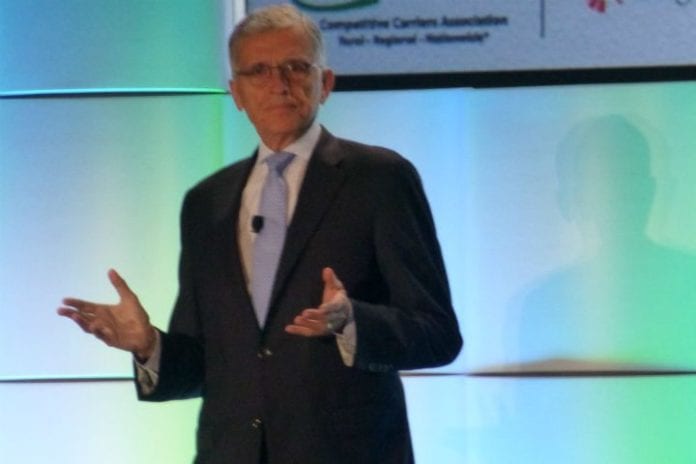Attendees at this week’s CCA event heard a pledge from FCC Chairman Tom Wheeler to tackle several hot-button topics for rural and regional carriers
SEATTLE – Just weeks after taking the stage at the CTIA Super Mobility event in Las Vegas to speak, Federal Communications Commission Chairman Tom Wheeler did the same at this week’s Competitive Carriers Association Annual Convention, though this time with some news for the audience.
Wheeler said before the end of the year he plans to move on updating the FCC’s data roaming framework in an attempt to drive down costs for rural and regional carriers looking to bolster their nationwide LTE coverage through agreements with larger carriers. Wheeler said the move would include calling on his fellow commissioners to adopt a Notice of Proposed Rulemaking on the hotly contested topic.
“Tackling this issue will allow the commission to provide greater certainty in the marketplace, and promote consumer benefits and competition,” Wheeler said.
The data roaming issue has been a top topic for CCA and its members dating back to 3G networks and the trade organization’s former title as the Rural Cellular Association. The FCC in 2011, did adopt rules requiring facilities-based providers of commercial mobile data services to offer data roaming arrangements to other such providers on “commercially reasonable terms and conditions, subject to certain limitations,” with rural carriers and CCA questioning what larger carriers seem to consider as “reasonable.”
The commitment drew pointed applause from many in the audience.
Wheeler also followed up on a previous commitment to tackle the ongoing issue of so-called business data services by the end of this year. Wheeler said he plans to present a reform proposal to the FCC that he claimed will tackle the issue of access and charges tied to backhaul services.
“I will present the commission with a reform proposal that will tackle this issue and encourage innovation and investment in what we now call business data services, while ensuring that lack of competition in some places cannot be used to hold back wireless coverage,” Wheeler said, taking aim at AT&T in adding, “notably, reform is supported by the nation’s leading wireless carriers, save one.”
AT&T has said “the facts show that competition in the BDS market is thriving,” according to Caroline Van Wie, assistant VP of federal regulatory at AT&T, in a recent blog post on the topic.
Earlier this year Wheeler touted the FCC’s BDS proceedings, in which the commission is looking to ensure broader access to wired backhaul assets for wireless networks. The move has drawn strong criticism from many cable providers and telecom operators.
To a more muted response, Wheeler also said the FCC will look to move forward with Phase 2 of the Mobility Fund by the end of the year. The fund, which was previously known as the Universal Service Fund, looks to “spur deployment of advanced wireless infrastructure, and replace the old ‘CETC’ support, which the commission concluded was not well-targeted.”
The FCC is looking to update how it collects data for the fund, noting the current system is similar to the old saying that “you can’t manage what you can’t measure.”
“Well, when it comes to measuring wireless coverage in America, our record, quite frankly, is – like coverage in many rural areas – spotty,” Wheeler said. “The problem is the way we collected data. For the one-time support distributed under Phase I of the Mobility Fund, we relied on a third party and used the data at the census-block level, which is getting down to a pretty small area. But it wasn’t granular enough, particularly for the geographically large census blocks found in rural areas. A census-block would get identified as having coverage. But, within that census block, the east side of the area might have service, while the west side has none.”
Looking to fix the issue, Wheeler said the current requirement for mobile carriers to submit Form 477, which contains network coverage data, is providing a more detailed picture on coverage gaps and the ability to reduce duplicative support for some areas.
“Every USF dollar used to support duplicative service is a dollar that is not available to bring service to the more than 550,000 miles of unserved roads where somebody might have an accident and need to contact 911,” Wheeler said. “That just won’t do.”
Speaking more broadly on the topics of 5G and spectrum auctions, Wheeler echoed comments from the CTIA event, noting the FCC needs to ensure the market has an ample supply of spectrum to foster the development and rollout of new wireless technologies. In terms of the spectrum work, Wheeler again touched on the FCC’s move to target low-, mid- and high-band spectrum resources in support of the telecom industry’s push into 5G.
Bored? Why not follow me on Twitter

